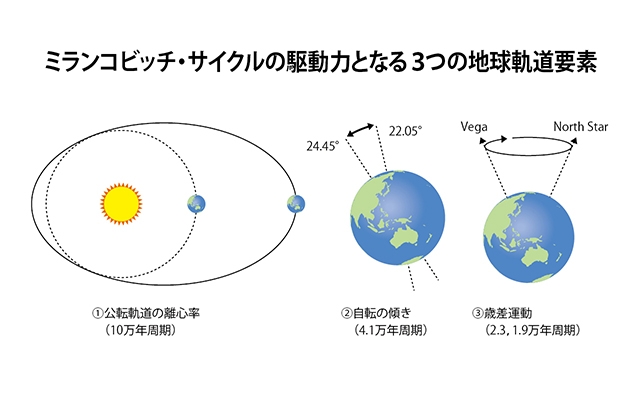最終氷期の機構変動図(準備中)
Coming soon

ミランコビッチ・サイクル
Milankovitch cycle
微化石とは・・・
北半球に大規模な大陸氷床が形成されてから現在にいたるまで、地球は寒冷な時期(氷期)と温暖な時期(間氷期)を繰り返し経験してきた。氷期-間氷期サイクルと呼ばれる現象である。ここでは氷期-間氷期サイクルを引き起こす主な原因である「ミランコビッチ・サイクル」について紹介する。
ミランコビッチ・サイクルとは、地球の表層で受け取る太陽の熱エネルギーの量(日射量)が、数万年のリズムで変化する現象である。日射量が変化するのは、地球軌道要素と呼ばれる(1)公転軌道の離心率、(2)自転軸の傾き、(3)歳差運動が変化するからである。簡単に言えば、地球はフラフラと揺らぎながら自ら回転したり(自転)太陽の周りを回る(公転)ことで、地表で受け取る日射量がリズミカルに変化するのである。北半球の大陸氷床の形成には特に北緯65度付近の日射量が重要である。そのような高緯度で日射量が少なく寒冷であると大陸上に氷床が発達して氷期になる。反対に、日射量が多く暖かいと大陸氷床は発達せずに間氷期となる。ミランコビッチ・サイクルによって氷期と間氷期の1セットが繰り返されるリズム(すなわち、氷期-間氷期サイクルの周期)は、主に約10万年、4万年、2万年であることが知られている。それに従えば、今から2万年ほど前は氷期、現在は暖かい間氷期であり、さらに数万年後の未来には再び氷期になることが予想される(☞E7_?ページ)。
このミランコビッチ・サイクルは、19世紀に天文学者のアダマールとクロールがそれぞれ提唱したアイディアを基に、20世紀初頭に地球物理学者のミランコビッチが改良して大きく発展させた理論である。ミランコビッチ・サイクルは、公表された当時には大きく注目を集めたものの、いつしか研究者から忘れられて過去の理論となってしまった。しかし、1970年代からはその正当性を証明する多くの証拠が得られるようになって大復活をとげた。そのミランコビッチ・サイクル説の復活劇の中心的な役割をはたしたのは、実はとても小さな化石(微化石)であった(☞3、4ページ)。
a microfossil is...
From the formation of the Northern hemisphere's large continental ice sheet to present days, the Earth has repeatedly experienced cold climate period called glacial period, and mild climate period called interglacial period. It is a phenomenon called the glacial-interglacial cycle. We will here introduce the "Milankovitch cycle", which is one of the main causes of the glacial-interglacial cycle.
The “Milankovitch cycle” is a phenomenon in which the amount of solar thermal energy (solar radiation) received by Earth's surface changes according a ten-of-thousand-year-long cycles. The amount of solar radiation changes when changes occur among the 3 following elements called orbital element:
1) The orbital eccentricity,
2) the inclination of the axis of rotation,
3) the precession movement
Simply put, the amount of solar radiation received on the surface changes rhythmically as the Earth rotates on its own while swinging (self-rotation) and turning around the sun (revolving). To form the continental ice sheet in the Northern hemisphere, the amount of solar radiation near the 65 degrees North is especially important.
If the amount of solar radiation is small and the weather cold at such high latitudes, then the ice sheet develops on the continent and the glacial period starts. On the contrary, if the amount of solar radiation is large and the weather warm, then the continental ice sheet will not develop and the Earth will enter into an interglacial period. The rhythm of those the Milankovitch cycle (ie, the period of the glacial - interglacial cycle) in which one set of glacial and interglacial cycles are mainly about 100,000 years, 40,000 years, 20,000 years. According to that statement, as a the previous glaciation occurred 20,000 years ago and as we are currently in a warm interglacial period, then we can predict that the Earth will once again enter into glaciation in a few ten thousands of years (☞E7_? Page).
The “Milankovitch cycle” theory was developed at the beginning of the 20th century by the geophysicist Milutin Milankovitch and greatly based on ideas developed and advocated by the mathematician Joseph Adhemar and the astronomer James Croll during the 19th century. Although the Milankovitch cycle attracted a lot of attention at the time of its publication, it was forgotten by researchers and became a theory from the past. However since the 70's, many evidence proving the validity of the theory emerged and the “Milankovitch cycle” theory underwent a large revival. In fact it was a very small fossil (microfossil) that played the main role of this resurrection (☞ page 3, 4).